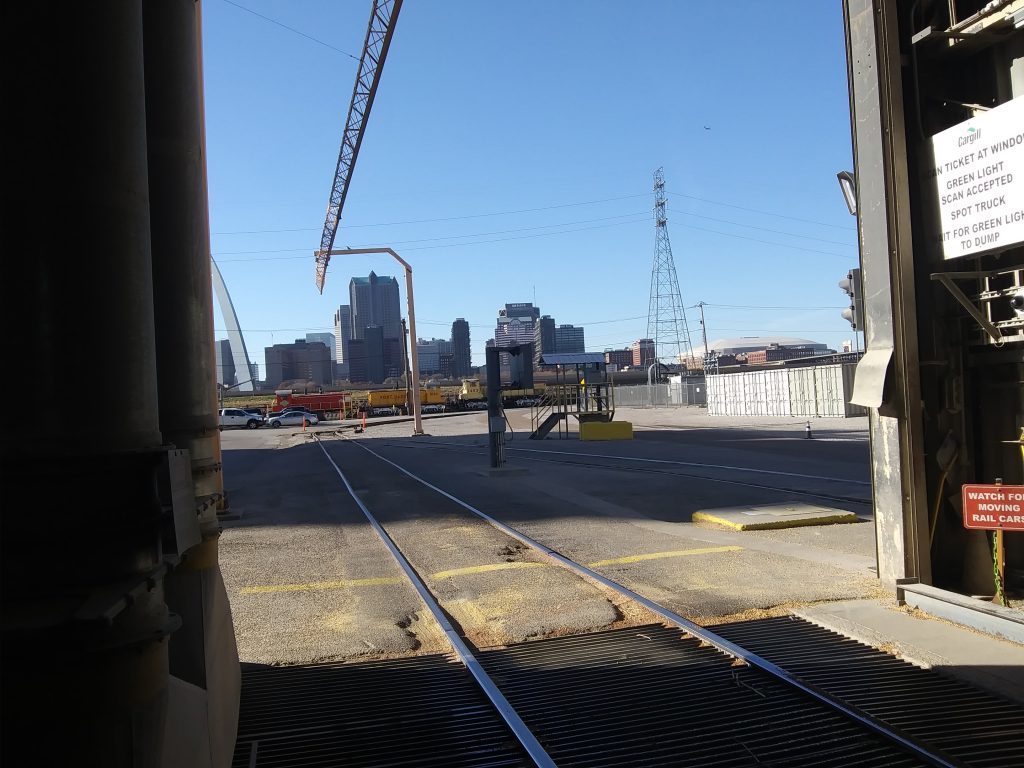Greg Lumsden, a Cargill product line leader, gave a “macro overview” of grain markets at a recent event sponsored by the St. Louis Agribusiness Club at Cargill’s grain elevators in East St. Louis, directly across the Eads Bridge from downtown St. Louis, Missouri.
About 70 members gathered to hear the overview, plus an update by the Army Corps of Engineers on the progress of work on an expanded 1,200-foot lock at Lock & Dam 25, upstream from St. Louis.
The current 600-foot lock, built in the 1930s, is a chokepoint for grain cargoes. Cargill has grain terminals all along the Illinois River and in St. Louis and the Upper Mississippi River. Its two terminals in Louisiana, at Westwego and Reserve, can handle 120,000 bushels an hour.
Five factors have been affecting United States grain exports, Lumsden said. The most challenging has been a huge increase in productivity from South American soybean producers, especially in Brazil, coupled with significant improvements in their logistics infrastructure. Brazilian production alone increased 19% year-over-year. China bought corn from Brazil for the first time ever this year, Lumsden said.
While yields of this year’s U.S. corn, wheat and soybean crops have been a little bit better than what was predicted earlier in the year, they were still dented by drought.
This means less inelastic demand for U.S. grains, he said. At one time the U.S. was the supplier of choice, despite price, because of quality and transportation reliability. Those advantages are being eroded.
On the plus side, China has made significant buys for its grain reserves from the U.S. after substantial purchases in the Brazilian soy and corn markets earlier in the year. There is less concern over Black Sea grain disruptions, Lumsden said—despite Russian destruction of Ukrainian export infrastructure—after Ukraine managed to reroute some exports and keep Black Sea grain moving.
Finally, long-term shifts in demand for biofuels and domestic crush—including for sustainable airline fuel—mean that U.S. export patterns could shift, with domestic demand for soybean oil for sustainable fuel uses leaving more soymeal and dried distillers grains for exports, rather than raw soybeans.
Andrew Paluska, a grain originator at Cargill, focused on the impact of low water in the Mississippi River and other waterways on exports. The low water has resulted in a narrower channel, smaller tows, more congestion and increased dredging.

“It’s like a highway moving from a six-lane highway to a two-lane country road,” he said. He gave high marks to the Corps of Engineers for its dredging program.
Jose Lopez, program manager of the Lock and Dam 25 Expansion Project for the St. Louis Engineer District, gave an update on its progress. The lock expansion project poured its first concrete Nov. 3, and had another pouring Nov. 15. It is currently on schedule and slightly under budget. Whether that will continue to be the case depends on many factors, according to Lopez.
The planned 1,200-foot lock will cut that transit time to 30 minutes. The project was authorized in 2007 but was not given any money by Congress until it was awarded $732 million in the Infrastructure Investment and Jobs Act in FY2022.
When the Corps was finally given the money, one of its first tasks was to “go back to the file cabinets” to look at the preliminary work from 2007, Lopez said. “You can lose a lot of institutional memory and momentum in that time,” he noted. “We’re in a design phase right now, and we’re crunching numbers” to figure out what conditions have changed and how the project can best move forward.
At the same time, the project team wants to move forward with whatever it can. Massman Construction Company won the contract in September 2022 for this phase of the project, which involves preparing the guide wall to receive an extension.
“It’s a lot harder to ‘bolt on’ an addition to an existing project built in the 1930s that it would be to build a new lock and dam from scratch,” Lopez said. Massman’s work is scheduled to wrap up in May 2024.
The target date for the new lock chamber to become operational is October 2034, with fiscal project completion by September 2036. One limiting factor is that the Corps intends to keep the existing 600-foot lock open during construction, to avoid drastic impacts to industry. That commitment lengthens the project timeline.
Lopez said members of Congress always ask, ‘How much will it cost?” That’s impossible to answer right now, he said. “That would be a forecast of a forecast.”
It’s not just because factors like inflation can’t be predicted, but because parts of the project are being bid out under a type of contract called Early Contractor Involvement-Integrated Design & Construction.
Contractors are invited to look at the Corps’ design to see how they could reduce costs, but details of bids can’t be made public until a winning bid is announced, to avoid giving unfair competitive advantage. Rising prices—what Lopez called “market escalation risk”—are still being felt by industry.
The project managers are aware that labor will have to be surged. At its height, the project will require between 300 and 400 skilled workers—who will have to be incentivized and trained. Since the area around Lock and Dam 25 is rural, even though it is not far from the St. Louis metro area, Lopez said laborers will have to be paid a premium.
The availability and price of some materials are getting better, he said, but not all. Contract placements have begun for Phase 1 construction.
David Murray can be reached at [email protected].




